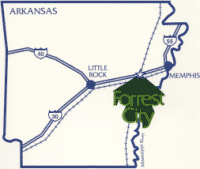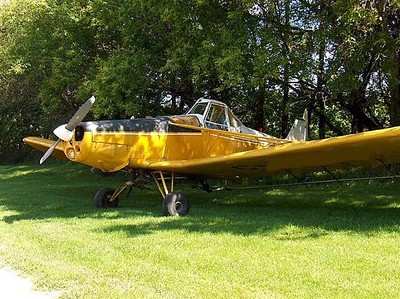New Commission Believes Shift In Priority Due
 The Forrest City Municipal Airport's newly appointed commission
has indicated the airport may be headed in a new direction after an
informational meeting Tuesday night in Forrest City, AR.
The Forrest City Municipal Airport's newly appointed commission
has indicated the airport may be headed in a new direction after an
informational meeting Tuesday night in Forrest City, AR.
A 393-foot extension of the runway, which the former board had
been seeking, doesn't strike the new board as being the most
important priority, according to the Forrest City Times-Herald.
The meeting focused instead on what improvements were actually
appropriate or even feasible. The formation of a regional airport
is very probable.
"I think we were in more or less an exploratory or fact finding
mode," said commission chair Pat Flanagin. "The options are all the
way from going to a $2.4 million program that was recommended in
2002, down to maybe doing as little as getting another wind sock.
But there are a lot of things in between, such as a parallel
taxiway."
Commission member Jeff Schwartz, a pilot, said if safety was a
priority, a parallel taxiway might take precedence over lengthening
the runway.
Flanagin agreed.
"I concluded... that if we are to do anything at all major, the
taxiway would be the first priority, because having someone trying
to land when someone else is having to turn around and taxi on the
runway is a recipe for disaster," he said.
He added he wasn't sure the city could match an estimated
$60,000 to go with a $200,000 and $300,000 grant from the state
Department of Aeronautics for the taxiway the board is hoping
for.
"I doubt the powers that be will want to make that size of an
investment in something that's not going to be used" should a
regional airport be built, Flanagin said.
But, things have changed somewhat since the last master plan was
developed.
"It was envisioned that our airport would be needed for
corporate use, other than predominantly agriculture planes,"
Flanagin said. "However, reality has shown us that the opposite is
true. The use of the airport by ag planes is probably higher than
it was five years ago."
Schwartz believes agriculture and other types of aircraft to be
a "bad mix" in the same airport and, while small corporate jets are
increasingly popular, there doesn't seem to be a need for this
airport to expand in that direction.
"It's easy for chamber of commerce types to say we've got to
have an airport where jets will be whizzing in and out," he said.
"But you've got to have something for the jets to whiz in and out
for."
Flanagin notes that when the original master plan was developed,
it took into account an expected increase in corporate jets
activity. Most of the companies flying jets listed in the report
have long since left.
"What we are in is kind of a holding pattern," Flanagin said.
"All the arguments made for why we should grow here will be met by
the regional airport. What is it that we need to do to satisfy the
needs of our community while this other thing (regional airport) is
getting fixed? And then the city will have to look at its resources
and say, 'do we want to keep this one and that one?'"
"The basic use for this airport is going to be predominantly
crop dusters. They're going to be the ones to use it. What's the
use of the city putting money into it?" Schwartz said.
Dan Clinton, an airport consulting engineer, presented a history
of the airport's planning, including a master plan financed by the
FAA that would have lengthened the existing runway from about 3,400
feet to 5,000 feet.
When the plan was presented at a public meeting in August of
2001, it met with disaster. Clinton recalls the incident as "that
meeting with all the people with the pitchforks."
All of the 150 people in attendance at that meeting opposed any
airport expansion.
"That was five and a half years ago," said Clinton. "And in
fact, some of those folks had buttons that said, 'We want a
regional airport.'"

FCY was forced to give up its federal funding to the regional
airport project when the city joined nearby Wynne to form a
regional airport commission a short time later.
The former airport commission still attempted to gain a smaller
runway extension with an $80,000 state grant, but ended up
returning the money when bids came at more than twice that amount,
even with $20,000 matched by the city. Those commission members
have since been replaced by the city council.
 ANN's Daily Aero-Linx (05.06.25)
ANN's Daily Aero-Linx (05.06.25) ANN's Daily Aero-Term (05.06.25): Ultrahigh Frequency (UHF)
ANN's Daily Aero-Term (05.06.25): Ultrahigh Frequency (UHF) ANN FAQ: Q&A 101
ANN FAQ: Q&A 101 Classic Aero-TV: Virtual Reality Painting--PPG Leverages Technology for Training
Classic Aero-TV: Virtual Reality Painting--PPG Leverages Technology for Training Airborne 05.02.25: Joby Crewed Milestone, Diamond Club, Canadian Pilot Insurance
Airborne 05.02.25: Joby Crewed Milestone, Diamond Club, Canadian Pilot Insurance




